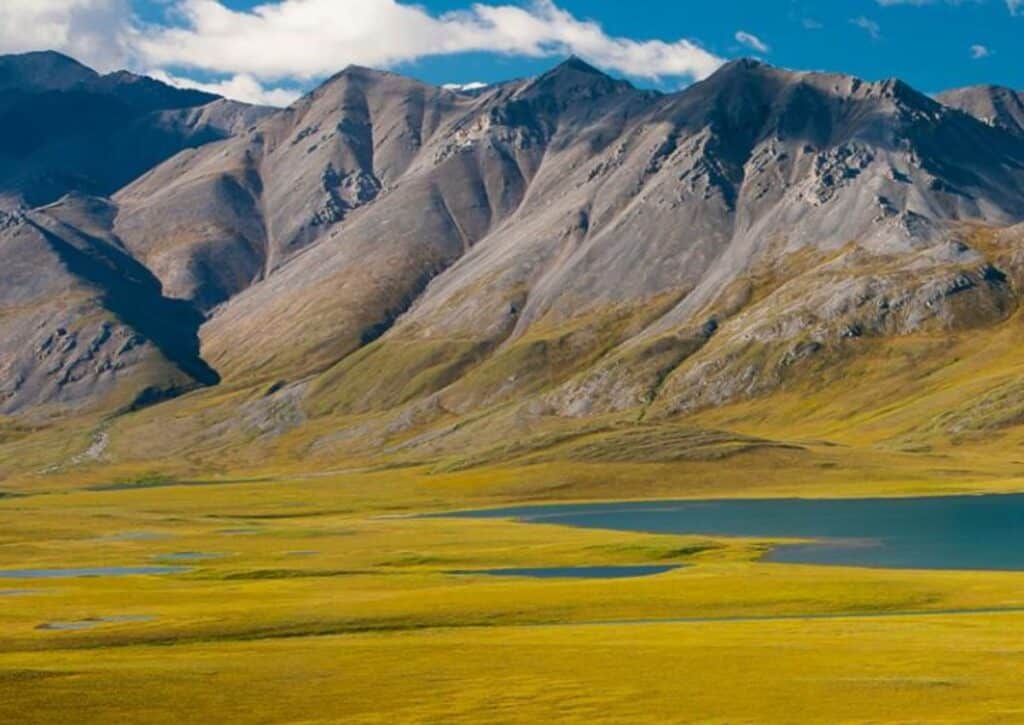Explore Kobuk Valley National Park: dunes, caribou, hikes, and unique Arctic adventures await!
Get ready to venture into Kobuk Valley National Park, a place where the wild Arctic comes alive with soaring sand dunes, icy blue waters, and wildlife spectacles that’ll leave you in awe.
This untouched paradise is a dream for adventurers and animal enthusiasts alike, offering a front-row seat to the epic caribou migration and the secret lives of predators like the gray wolf.
With activities that take you from the tranquility of a river raft to the thrill of conquering 100-foot dunes, we’re going to guide you through the unique experiences that Kobuk Valley has in store.
Whether you’re a hiker, a birder, or just someone who appreciates nature in all its raw beauty, this park is full of surprises. Get the scoop on the best spots for wildlife watching, the top trails for every skill level, and even how to camp under a sun that never sets.
Our journey through Kobuk Valley isn’t just about places; it’s about moments that define the wild spirit of the Arctic. Let’s dive into the heart of one of America’s least-visited national parks and discover all the reasons why this hidden gem deserves a spot on your bucket list.
History of Kobuk Valley National Park
Established in 1980 under the Alaska National Interest Lands Conservation Act, Kobuk Valley National Park encompasses a sprawling 1.7 million acres.
This decision to grant it the status of a national park wasn’t merely for its stunning landscapes but underscored a broader intent: preserving the area’s immense ecological and cultural value.
Why Was Kobuk Valley Made a National Park?
Kobuk Valley was recognized not just for its unique combination of sand dunes and arctic environments but also its significance as a vital corridor for one of the last great wildlife migrations: the annual movement of the Western Arctic caribou herd. Over 400,000 caribou journey across its terrains.
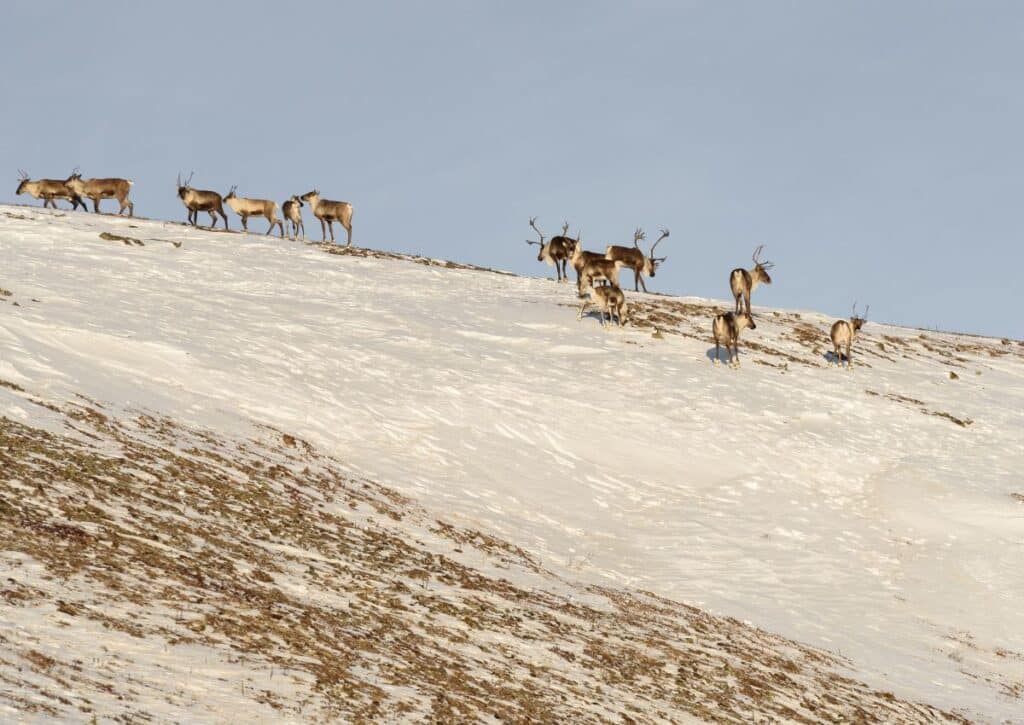
Additionally, with remnants of cultures over 12,500 years old, the park protects an ancient history and the enduring traditions of its indigenous people.
Traditional Inhabitants and Their Relationship with the Land
The Inupiaq people, the indigenous inhabitants of the region, have fostered a deep relationship with the valley for countless generations.
This land provided sustenance, shelter, and was central to their cultural narratives. Especially pivotal is the caribou, an animal intertwined with the Inupiaq’s sustenance and spiritual practices.
Evolution Over the Years:
While the park’s environmental characteristics have remained relatively stable, human interactions with the valley have evolved. Over millennia, the Inupiaq navigated challenges, from climatic shifts to external influences, adapting while preserving their intimate connection with the land.
How Old is Kobuk Valley National Park?
Officially designated as a national park on 2nd December 1980, Kobuk Valley National Park is now over four decades old. Yet, its story is ancient, with its land bearing witness to millennia of ecological transformations and human history.
The Animals, Birds, and Plants in Kobuk Valley National Park
Kobuk Valley National Park is a treasure trove of biodiversity, offering a rich tapestry of life in a region where the extremes of nature come into play.
The park is a mosaic of habitats, from the wetlands along the Kobuk River to the sand dunes and boreal forests, each contributing uniquely to its ecology.
Mammals are the park’s prime attraction, with the Western Arctic caribou herd taking center stage.
These majestic animals migrate across the park in vast numbers, a spectacle that remains unmatched.
Beyond the caribou, the park shelters the likes of gray wolves, moose, and brown bears, each playing their part in the park’s intricate food web.
The skies above are frequented by birds such as the golden eagle, peregrine falcon, and various waterfowl, who find the park’s water bodies ideal for nesting and sustenance.
The flora, while understated in comparison to the fauna, is no less fascinating. The land blooms with a variety of plants like wild berries, lichens, and iconic Arctic flowers.
All in all, Kobuk Valley stands as a testament to nature’s resilience and diversity, flourishing amidst the challenges of the Arctic.
22 Animals and Birds We Saw While Hiking in Kobuk Valley National Park
Western Arctic Caribou
The Western Arctic Caribou, a defining icon of Kobuk Valley, roams its vast expanses in numbers that often boggle the mind. Majestic and graceful, these creatures form the heart and soul of the Arctic wilderness in the park.
A signature spectacle is their migration, where they traverse the valley twice a year. Watching thousands of caribou stampede across the Great Kobuk Sand Dunes is an experience unparalleled, making it a bucket-list event for many nature enthusiasts.
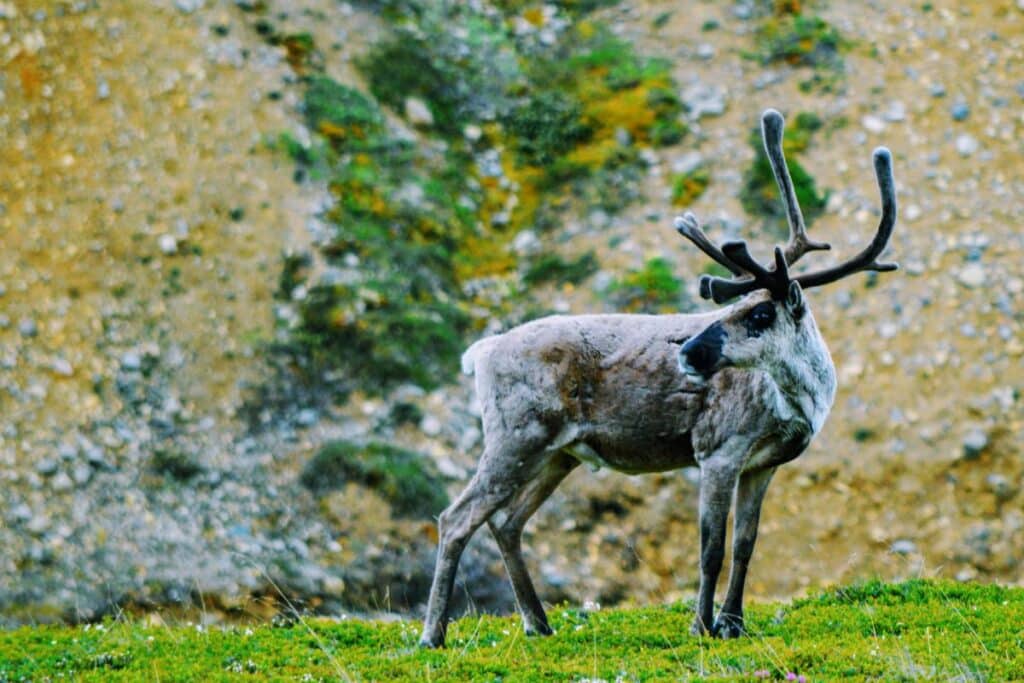
Visitors keen on observing this grandeur should head towards the Great Kobuk Sand Dunes or the valley expanses. While there isn’t a specific trail that guarantees a sighting, the areas around the dunes, especially during migration seasons, offer the best chances.
But what’s truly astounding about these caribou in Kobuk is their sheer resilience. Surviving and thriving in such extreme Arctic conditions, they’ve adapted over time, showcasing shorter legs and thicker coats to combat the cold.
Their annual journey, covering long distances, stands testament to nature’s incredible endurance and the timeless wonders of Kobuk Valley.
Gray Wolf
The majestic Gray Wolf, a beacon of the wild frontier, reigns with quiet authority within the confines of Kobuk Valley. The park echoes with tales of their prowess, and catching even a fleeting glimpse of one is a testament to the wilderness of the Arctic.
Wolves favor the sheltered realms of the boreal forests, but they’ve been notably sighted around areas such as the Onion Portage and near the edges of the Little Kobuk and Hunt River dunes.
For a structured adventure, the Tundra Trail, which navigates through dense woodland and open spaces, provides a promising chance to spot these predators.
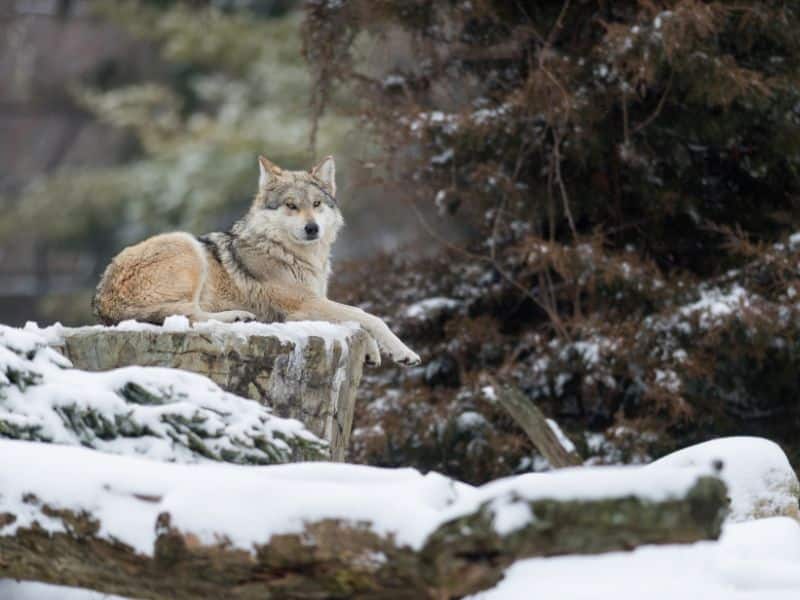
The late hours of dusk and early dawn on the Akununaktuk River Trail have often been accompanied by the distant howl of the wolves, signaling their movement and hunts. A quiet, patient vigil here can sometimes reward with a sight of them in their natural element.
Unique to Kobuk’s wolves is their strategic hunting pattern, especially during the caribou migration. They often position themselves between the Great Kobuk Sand Dunes and the valley, anticipating the caribou’s path.
To witness a Gray Wolf in Kobuk is to immerse oneself in a deep Arctic narrative, where every trail and dune tells stories of survival, elegance, and the eternal dance of predator and prey.
Brown Bear
Mighty and awe-inspiring, the Brown Bear is one of Kobuk Valley’s most magnificent residents. Emblematic of the raw power of nature, these bears are a testament to the enduring spirit of the Arctic wilderness.
Frequenting the regions around the Kobuk River, they often come into view during the salmon runs, where they showcase their fishing prowess. The areas around the Salmon River and areas adjacent to the Pah River offer splendid chances for bear sightings, especially during late summer when the fish are abundant.
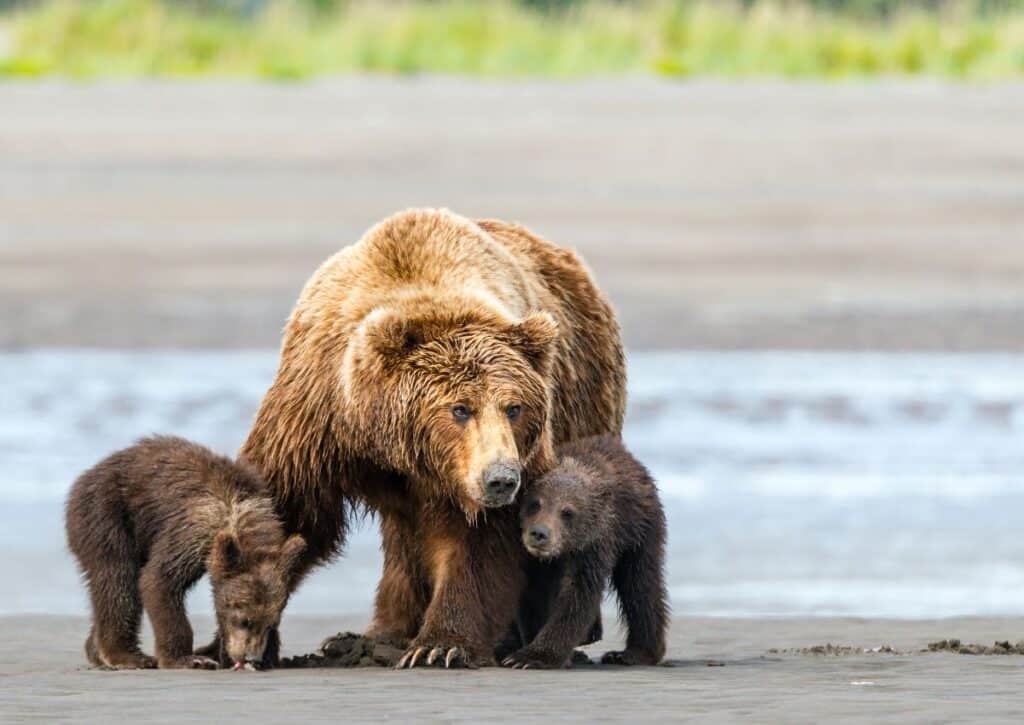
For the avid trekker, trails near the Walker Lake and Jade Lake provide a scenic backdrop and the potential to come across these bears in their natural habitat. But always remember to maintain a safe distance and employ bear-safe practices while hiking.
Brown Bears in Kobuk are unique, often distinguished by their darker and thicker fur – a natural adaptation to the park’s colder climate. It’s not uncommon to find them sifting through the shores, digging for clams, or feasting on berries.
Experiencing the grandeur of a Brown Bear in Kobuk Valley is a profound moment, a blend of admiration and respect. It’s a reminder of the delicate balance of nature and the beauty that unfolds when the wild is left undisturbed.
Moose
The towering Moose, with its impressive antlers and stately demeanor, is a quintessential part of the Kobuk Valley experience.
These herbivores, the largest in the deer family, carry a sense of calm and grandeur as they traverse the park’s varied terrains.
Kobuk’s wetlands and dense forested areas, especially around the areas of Selby Lake and the Kugururok River, are prime moose territories. The thickets provide them both sustenance and shelter.
For those venturing out on trails, the Shungnak River Trail often offers the delightful surprise of a moose sighting, especially during the early morning mists or the dim light of dusk.
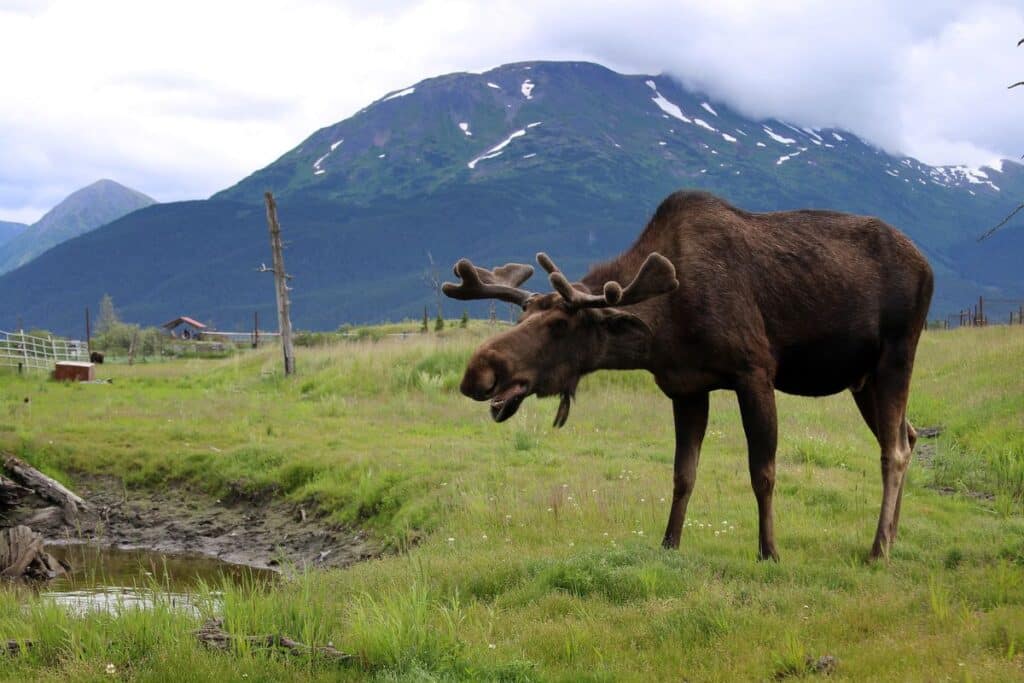
Visitors looking for a more in-depth experience might consider the trails near Zane Hills, a spot where moose often graze during the summer months.
The meadows and the water bodies in this region provide ample food, making it a hotspot for these gentle giants.
Kobuk’s moose have a certain robustness to them. Their shorter ears, thickened skin, and stocky build are evolutionary adaptations to the Arctic chill.
But it’s their tranquil grace, especially when seen reflecting off a still pond or silhouetted against the evening sky, that makes them so endearing.
Witnessing a moose in Kobuk Valley is akin to stepping into an age-old Arctic tale – a moment of serenity, a brush with the sublime, and a true celebration of the wild.
Arctic Fox
Lithe and agile, the Arctic Fox is a master of survival in the challenging landscapes of Kobuk Valley. With its pristine white winter coat and a keen sense of its surroundings, this small predator embodies the essence of Arctic adaptability.
The tundra regions, especially around the areas of the Ahnewetut Creek and the Agie River, often play host to the Arctic Fox. Their burrows, small and inconspicuous, dot these landscapes, providing a snug refuge against the biting cold.
For those keen on sighting these foxes, the trails surrounding the expansive Waring Mountains offer promising encounters.
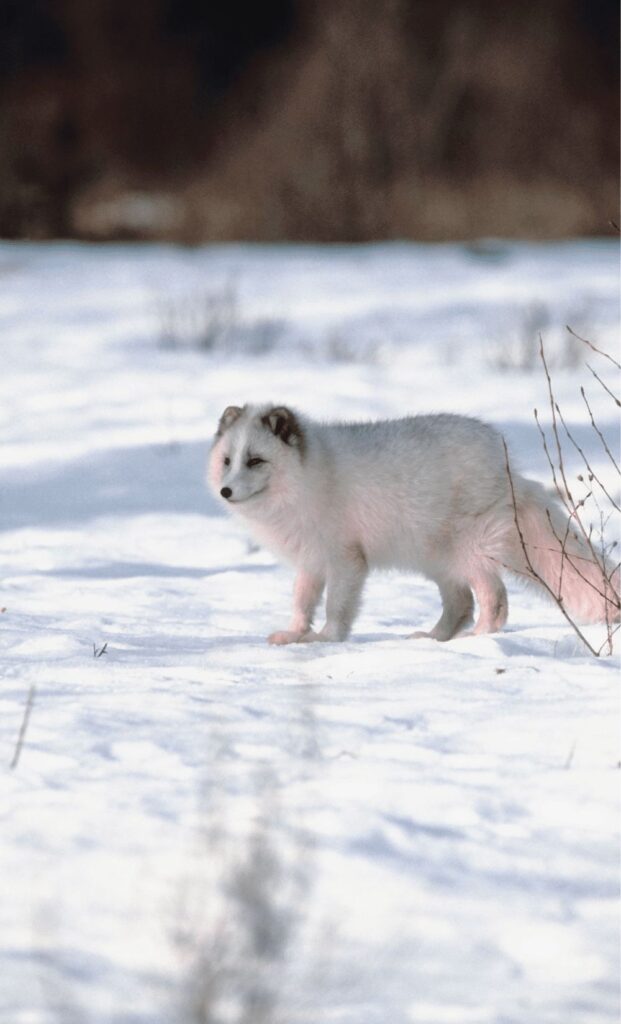
In summer, as the Arctic day stretches long, their coat transitions to a brownish-grey hue, offering camouflage against the tundra’s rocky outcrops. This change, while a survival tactic, also offers an enchanting spectacle for wildlife enthusiasts.
What’s intriguing about the Arctic Foxes in Kobuk is their symbiotic relationship with larger predators like the Brown Bear. Often trailing behind them, these foxes scavenge on leftover prey, ensuring nothing goes to waste in this harsh ecosystem.
A sighting of the Arctic Fox, with its bushy tail and curious eyes, is a delightful experience in Kobuk Valley. It speaks of the park’s untamed spirit, the circle of Arctic life, and the delicate balance that keeps this ecosystem thriving.
Golden Eagle
Sovereign of the skies, the Golden Eagle is a sight of sheer majesty within Kobuk Valley’s expansive horizon. With powerful wingspans and piercing eyes, they reign supreme, offering a masterclass in aerial prowess against the backdrop of the Arctic wilderness.
The cliffs and high vantage points near the Walker Mountains and the Ambler River are prime territories for these raptors. Here, they build their aeries, often returning year after year to the same nesting sites.
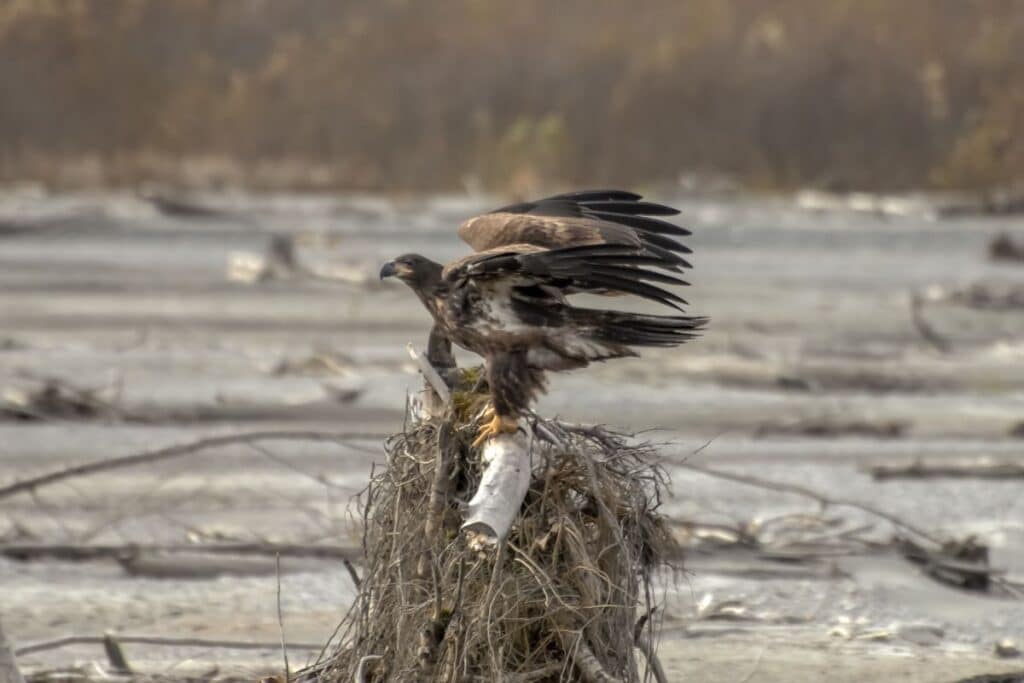
For those wishing to witness the magnificent flight of these eagles, the trails around the Kalhabuk Mountains offer panoramic views and the occasional thrilling sight of an eagle dive in pursuit of prey.
Summer months in Kobuk see them riding the warm thermals, their sharp eyes scouting for ground squirrels, hares, or even young caribou. The eagle’s unparalleled vision, almost eight times sharper than a human’s, allows them to spot a potential meal from great heights.
A unique aspect of Kobuk’s Golden Eagles is their symbiotic relationship with the valley’s topography. They use the undulating terrains to their advantage, often soaring low to surprise prey or utilizing mountain updrafts for effortless glides.
Witnessing a Golden Eagle in the skies of Kobuk Valley is a testament to nature’s grand design. It is an experience of raw power and grace, a dance of freedom, and a direct gaze into the untamed heart of the Arctic.
Peregrine Falcon
Dashing through the skies at breakneck speeds, the Peregrine Falcon stands as a symbol of agility and precision within the vast realm of Kobuk Valley.
Often referred to as the “cheetah of the sky,” its aerial acrobatics and hunting prowess are unparalleled, providing a breathtaking spectacle for those fortunate to witness it.
The steep cliffs that line the banks of the Kobuk River and the rugged outcrops near the Sevuokuk Mountain are favorite nesting grounds for these falcons.
They choose such high terrains for the vantage point it provides, enabling them to spot and swoop down on their prey with deadly accuracy.
Adventurers exploring the trails around the Kobuk River Basin might be treated to the sight of a Peregrine Falcon’s dive, a maneuver that’s as swift as it is deadly.
During their hunting forays, these falcons are known to reach speeds of up to 240 mph, making them the fastest animals on the planet. In Kobuk, their primary diet includes smaller birds, which they often catch mid-air in a display of sheer athleticism.
What makes the Peregrine Falcons of Kobuk particularly fascinating is their recovery story. Once on the brink due to the effects of pesticides, their numbers have rebounded in recent decades, making them a symbol of conservation success in the region.
Catching a glimpse of the Peregrine Falcon in Kobuk Valley is to witness nature’s aerodynamic marvel. It’s a display of speed, strategy, and survival, epitomizing the wild essence of the Arctic landscape.
Snowy Owl
With its regal stance and mesmerizing golden eyes, the Snowy Owl is a beacon of elegance and mystery in the vast expanses of Kobuk Valley.
Its pristine white feathers, contrasted against the tundra’s earthy hues, create a visual spectacle that captivates nature enthusiasts and bird watchers alike.
The open tundra regions, especially around areas like the Agiak Lake and the Kugarak River, are preferred hunting grounds for these magnificent birds. They sit tall and still, keenly observing their surroundings, ready to pounce on unsuspecting prey.
For those traversing the Ernie Pass, keep an eye out for these elusive birds, often seen scanning the horizon from elevated perches or rocky outcrops.
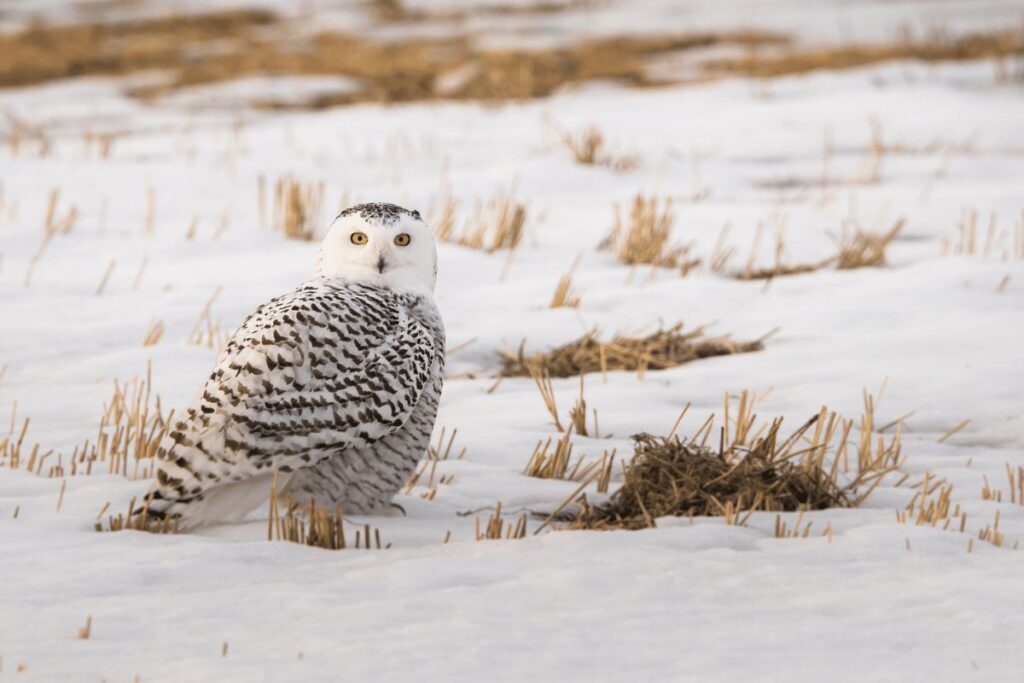
Adapted to the Arctic life, Snowy Owls primarily feast on lemmings, making the cyclical population of these rodents pivotal to the owls’ survival. During lemming boom years in Kobuk, it’s not uncommon to spot multiple owls within close proximity, a testament to the abundance of their favorite meal.
Unique to the Snowy Owls of Kobuk is their diurnal hunting habit. Unlike many of their owl counterparts, these birds can often be seen hunting during the day, taking advantage of the Arctic’s prolonged daylight in the summer months.
Witnessing a Snowy Owl in the serene setting of Kobuk Valley is a moment of pure wonder. It serves as a gentle reminder of nature’s beauty, the intricate balance of Arctic ecosystems, and the silent poetry of the wild.
Lynx
Gracefully treading the boundary between shadow and light, the elusive Lynx, with its tufted ears and penetrating gaze, is a creature of silent prowess in Kobuk Valley.
Their stealthy movements and the ethereal beauty they exude make them one of the most sought-after sightings for wildlife enthusiasts venturing into the Arctic domain.
The dense boreal forests surrounding Oksrukuyik Creek and areas close to the Pitmegea River provide the ideal habitat for these solitary cats.
Their large paws, adapted for snowy terrains, leave distinct tracks on the forest floor. For those navigating the dense woodlands of the Narvak Creek trail, a quiet approach might yield the rare sight of a Lynx on the prowl.
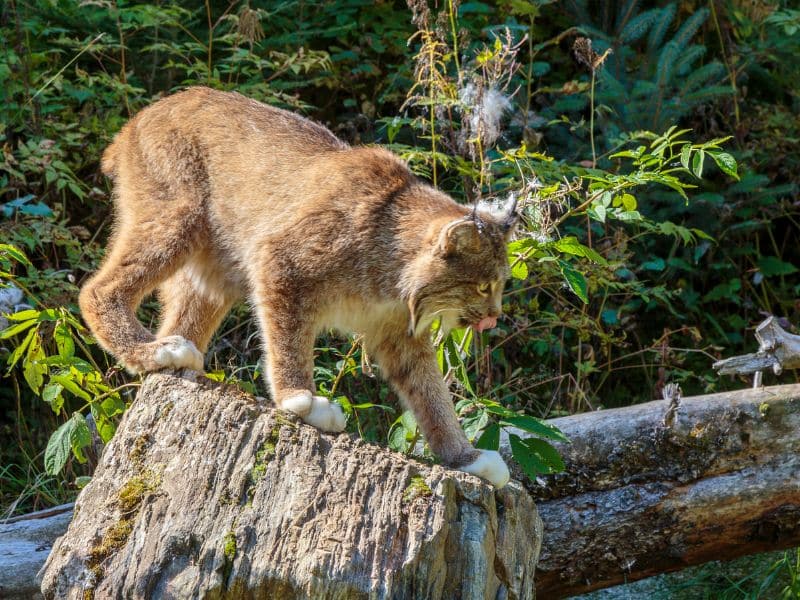
In Kobuk, the Lynx’s primary diet revolves around the snowshoe hare. Their population dynamics are intricately tied to the cyclical nature of hare abundance, leading to years of bounty followed by leaner times.
One remarkable aspect of the Lynx in Kobuk is their ability to traverse vast distances in search of food. Their territories are expansive, and they’ve been known to cover large areas of the park, marking their presence with subtle signs like scratch marks or cached prey.
Spotting a Lynx in the verdant embrace of Kobuk Valley is akin to unlocking a hidden Arctic secret. It’s a brief encounter with the enigmatic, a dance with the unpredictable, and a timeless moment in the heart of the wilderness.
River Otter
Gleefully sliding down riverbanks and playfully navigating the waterways, the River Otter brings a touch of whimsy and joy to the otherwise solemn landscapes of Kobuk Valley.
Their lithe bodies, adapted for streamlined swimming, and their curious nature make them a delightful presence in the park’s freshwater ecosystems.
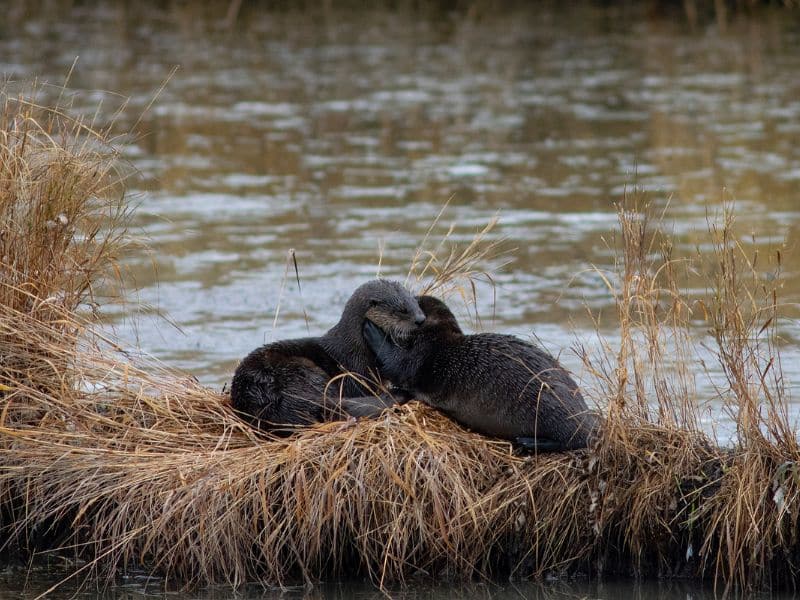
The winding channels of the Kobuk River, especially the segments near the confluence with the Little Kobuk and the Jade Rivers, are popular playgrounds for these energetic creatures. Their sleek forms can be spotted darting beneath the water’s surface or basking on the sun-warmed banks.
For those following the trails around the Hunt River, the sight of otters playfully wrestling or sliding down muddy embankments offers an endearing spectacle.
Diverse and opportunistic in their diet, River Otters in Kobuk feed on fish, amphibians, and sometimes even small mammals. Their agile dives and rapid pursuits are a testament to their adaptability and the health of the park’s aquatic ecosystems.
A distinct feature of Kobuk’s River Otters is their communal behavior. Unlike some other regions, here they are often seen in small groups, engaging in synchronized swimming or collective hunting, showcasing the park’s nurturing environment.
Observing a River Otter in Kobuk Valley is an experience infused with charm and vitality. It’s a heartwarming glimpse into the playful side of nature, and a reminder of the vibrant life that thrives in even the most remote corners of the Arctic.
Arctic Ground Squirrel
Chattering away amidst the vast Arctic expanse, the Arctic Ground Squirrel is a sprightly presence in the undulating terrains of Kobuk Valley. These small mammals, with their alert eyes and striped backs, offer a lively counterpoint to the park’s often quiet landscapes.
Across the sweeping plains near Onion Portage and along the trails that meander through the Zane Hills, these squirrels establish their burrows.

These intricate underground homes not only offer shelter but also serve as vital storage points for the harsh winters. Travelers treading the pathways of Tundra Lake might often hear their distinct calls, a sign of their ever-watchful nature.
In Kobuk, the diet of the Arctic Ground Squirrel includes a diverse range of plants, seeds, and occasionally insects. Their keen sense of timing allows them to harvest and cache food when it’s abundant, ensuring survival during the long, cold months.
What’s truly fascinating about the Arctic Ground Squirrels of Kobuk is their deep hibernation cycle. As the Arctic winter takes hold, these squirrels enter a profound torpor, with their body temperatures plummeting to near freezing.
This state of suspended animation, lasting almost 8 months, is one of nature’s most remarkable adaptations.
Encountering an Arctic Ground Squirrel in Kobuk Valley is a lesson in resilience and adaptation. Their bustling activity, set against the serene backdrop of the Arctic, serves as a vibrant reminder of life’s tenacity in the face of adversity.
Muskox
Majestically roaming the tundras, the Muskox stands as a relic of the Pleistocene era, a living testament to a bygone age.
Their thick, woolly coats and robust stature make them uniquely equipped to face the challenges of the Arctic, granting them an almost mythical aura in the landscapes of Kobuk Valley.
The expansive meadows near the Great Kobuk Sand Dunes and the lush valleys around Salmon River are favored grazing grounds for these ancient herbivores.
Their herds, often seen in tight, protective circles when threatened, graze on the Arctic willows and sedges that abound in these areas. The vastness of the Awry Lake vicinity also provides a serene backdrop for observing these animals in their natural habitat.
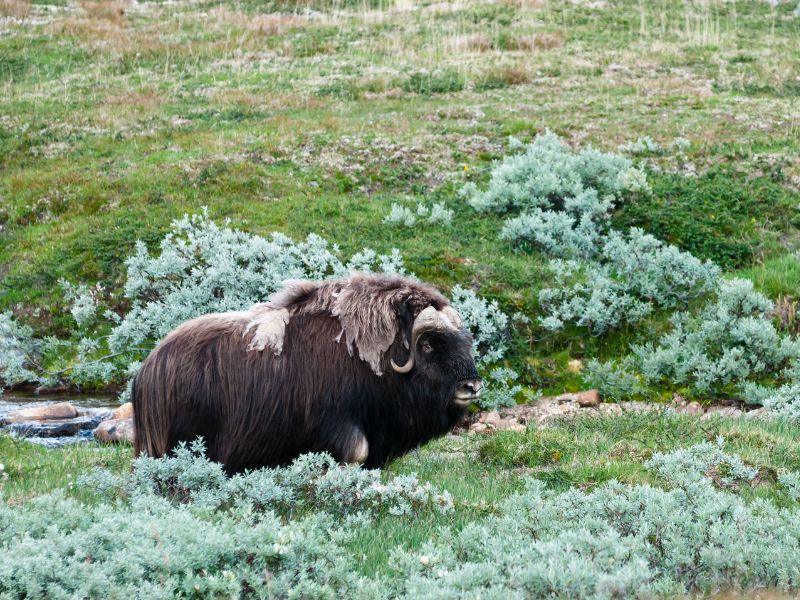
Primarily grazers, Muskoxen in Kobuk consume a variety of grasses, forbs, and shrubs. Their unique digestive systems allow them to extract nutrients efficiently, a crucial adaptation for the nutrient-poor Arctic environment.
A distinctive aspect of Kobuk’s Muskoxen is their “qiviut” – the soft underwool that sheds annually. This wool, warmer than sheep’s wool and softer than cashmere, is sought after for its unique properties and plays a role in local indigenous handicrafts.
Witnessing a Muskox in Kobuk Valley is like stepping back in time. The raw power they exude, combined with their dignified presence, makes for an awe-inspiring experience – a deep connection to the ancient heartbeats of the Arctic.
Red Fox
Among the muted shades of the Arctic, the Red Fox emerges as a burst of fiery elegance, its amber coat contrasting vividly against Kobuk Valley’s landscape.
This agile predator, with its bushy tail and sharp senses, adeptly navigates the tundras and forests, a beacon of adaptability and cunning.
The more wooded regions near Drain Creek and the grasslands surrounding the Kavet Creek offer prime hunting grounds for the Red Fox.
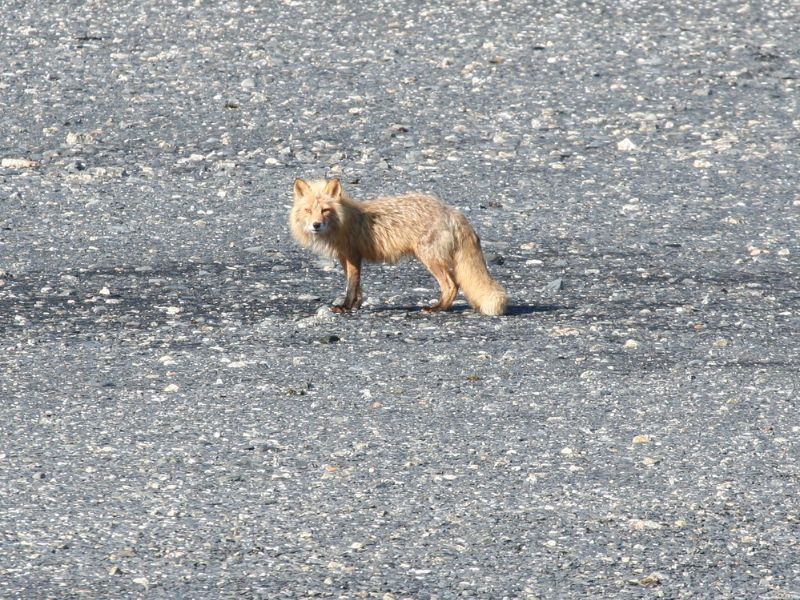
Visitors wandering the trails of Twin Lakes might spot their darting forms as they pursue a variety of prey, from voles to birds.
In Kobuk, the diet of the Red Fox is an eclectic mix, a testament to its opportunistic nature. Whether scavenging leftovers from larger predators or catching smaller mammals, the fox showcases its versatile survival skills.
What distinguishes the Red Foxes of Kobuk is their intricate den systems, often reused and expanded over generations. These underground mazes serve as nurseries, storages, and shelters from the Arctic chill.
Witnessing a Red Fox in Kobuk is an encounter with the wild’s astute strategist. Their graceful movements and keen intelligence offer a vibrant portrayal of life in the Arctic extremes.
Bald Eagle
Soaring regally over Kobuk Valley, the Bald Eagle, with its iconic white head and massive wingspan, is a symbol of freedom and majesty.
As the national bird of the United States, its presence in the park adds a touch of patriotic reverence amidst the natural splendor.
The towering cliffs flanking the Noatak River and the large trees dotting the shores of Kolby Lake provide nesting sites for these raptors. Their majestic silhouettes can often be seen circling the skies, scouting for fish or other prey.
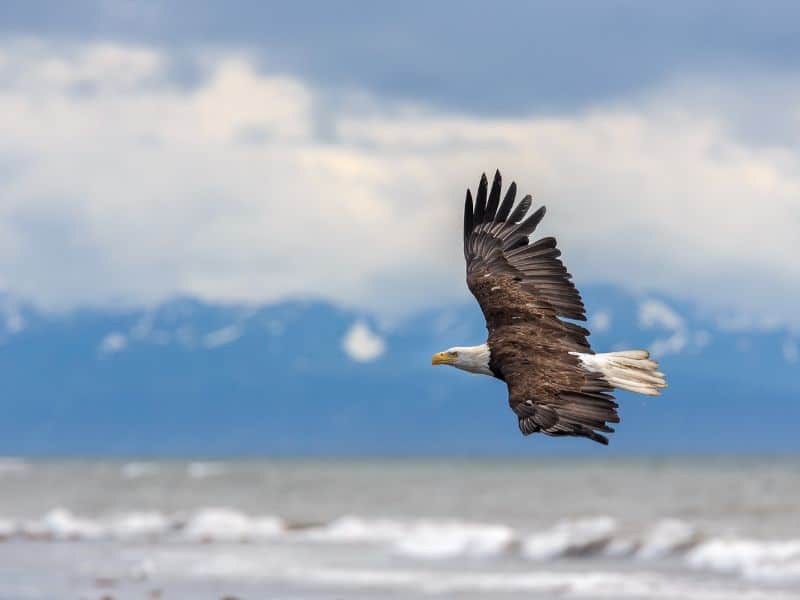
Primarily piscivorous in Kobuk, the Bald Eagle’s sharp eyesight aids in spotting fish from great heights, subsequently diving with pinpoint accuracy to snatch their meal.
A remarkable feature of Kobuk’s Bald Eagles is their fierce territoriality. Their vocal calls, echoing across the valley, serve as stern warnings to intruders, ensuring the safety of their nests and chicks.
Observing a Bald Eagle in Kobuk Valley is a spiritually uplifting experience. Their grandeur and solemnity resonate deeply, epitomizing the untouched beauty of the wilderness.
Northern Harrier
Gliding low over the marshes and meadows of Kobuk Valley, the Northern Harrier is an aerial dancer, its flight a delicate balance of poise and purpose.
With its distinctive facial disk resembling an owl’s and its slender frame, this raptor brings a unique flair to the park’s avian community.
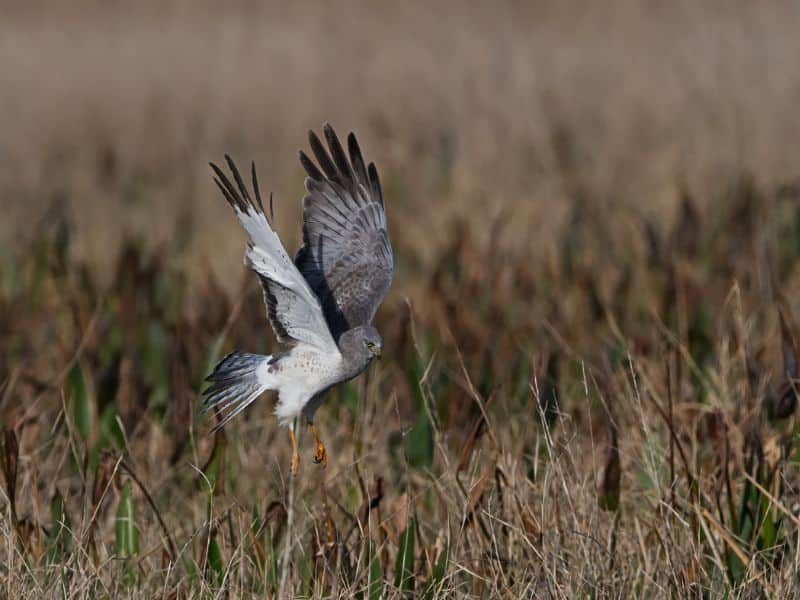
The wetlands near the Beaver Creek and the grassy expanses of the Pah River are often frequented by these birds. Their unique hunting style involves slow, methodical flights, often just above the vegetation, as they search for small mammals or birds.
Unlike many other raptors, Northern Harriers rely heavily on their sense of hearing, facilitated by their owl-like facial discs, to locate prey in dense vegetation. This adaptation is especially useful in Kobuk’s lush summer months.
An intriguing aspect of the park’s harriers is their nesting behavior. Building their nests on the ground, often in dense grass or reeds, they showcase a different dimension of life at ground level in the Arctic.
Witnessing a Northern Harrier in Kobuk Valley is a study in grace and precision. Their serene flights, punctuated by sudden dives, encapsulate the rhythms of nature in this pristine Arctic haven.
Gyrfalcon
The fierce Gyrfalcon, the largest of all falcon species, commands the skies of Kobuk Valley with its striking plumage and formidable hunting skills.
A true emblem of the Arctic wilderness, its robust physique and adaptability make it a top predator in the region’s often unforgiving climes.
The rocky outcrops and cliffs skirting the Kugururok River serve as favored perching and nesting spots for the Gyrfalcon.
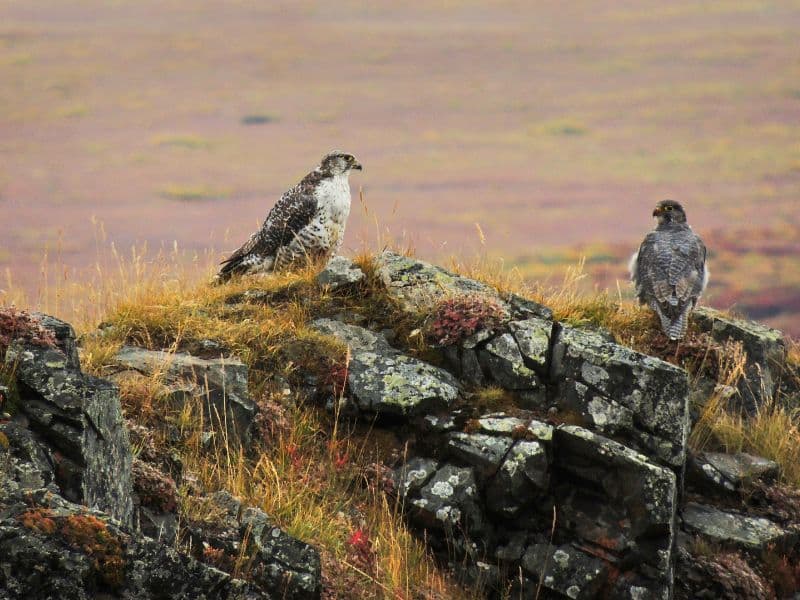
Travelers exploring the scenic vistas of Agie River might be fortunate enough to witness their powerful dives as they target ptarmigans or ground squirrels.
A standout trait of the Gyrfalcon in Kobuk is its varying color morphs, ranging from nearly pure white to dark gray.
This diversity in plumage offers them a degree of camouflage against the changing landscapes, be it snow-clad terrains or rock-studded vistas.
Their thickly feathered talons, a unique adaptation to the Arctic cold, further highlight their evolution to dominate Kobuk’s icy realms. Observing a Gyrfalcon in Kobuk is akin to watching Arctic royalty, a blend of grace, strength, and raw power.
Beaver
The industrious Beaver, nature’s skilled engineer, plays a transformative role in Kobuk Valley.
With their sharp teeth and persistent nature, they fashion entire habitats, turning streams into ponds and creating lush wetlands from meandering rivers.
The quieter tributaries of the Sevuokuk River and the dense woodlands surrounding Ammaruk Lake bear testament to the beaver’s architectural prowess. Dam constructions, lodges, and telltale chewed tree trunks signal their active presence.
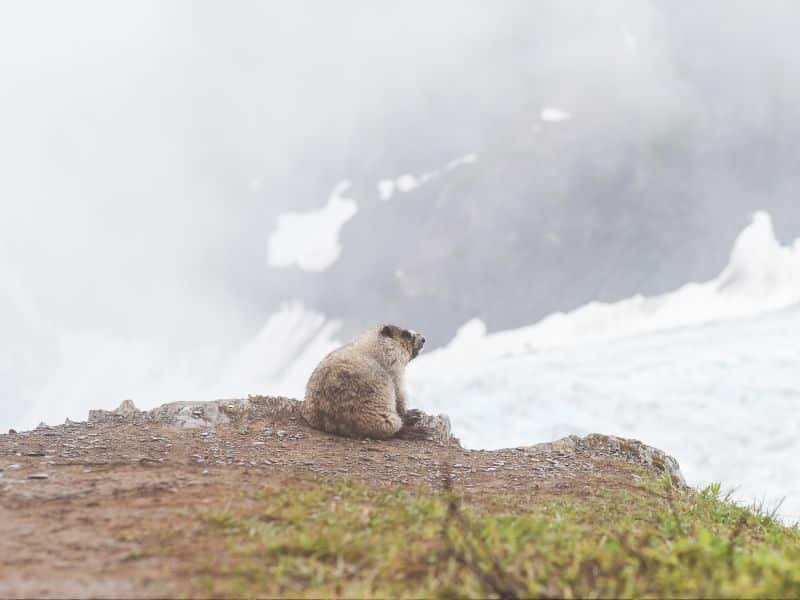
In Kobuk, Beavers primarily feast on the inner bark of trees like willow, aspen, and birch. During the winter, they survive on food caches they’ve diligently stored during the warmer months.
Perhaps the most intriguing aspect of Kobuk’s beavers is their pivotal role in enhancing biodiversity. By creating ponds, they provide habitats for a plethora of other species, from ducks to otters, amplifying the park’s ecological richness.
Witnessing a Beaver’s activities in Kobuk Valley is a firsthand lesson in nature’s ingenuity. Their relentless drive and transformative touch reshape the land, weaving a vibrant tapestry of life.
Sandhill Crane
Echoing their haunting, trumpeting calls across the valley, the Sandhill Cranes lend an ethereal quality to the soundscape of Kobuk.
Their stately presence, with long legs and necks, coupled with a distinctive red forehead, adds a touch of elegance to the park’s avian ensemble.
The wet meadows near the Pelican River and the expansive shores of Dark Lake serve as both breeding grounds and migratory stopovers for these majestic birds. During their migratory flights, the skies above the Tisuk River might be filled with their synchronized formations, a sight to behold.
In Kobuk, Sandhill Cranes are omnivorous, feeding on a mix of plant tubers, grains, and small animals. Their intricate courtship dances, characterized by graceful leaps and wing flapping, are a mesmerizing spectacle during the breeding season.
A distinctive feature of the cranes in Kobuk is their long-distance migration. Connecting the Arctic to the southern parts of North America, their journey epitomizes nature’s incredible endurance and tenacity.
Observing a Sandhill Crane in Kobuk Valley bridges the terrestrial and the ethereal. Their poised elegance, set against the rugged Arctic backdrop, weaves a narrative of resilience, grace, and timeless wanderlust.
Dall’s Sheep
High up on the rugged limestone cliffs of Kobuk Valley, Dall’s Sheep – with their striking white coats and majestic curled horns – stand as sentinels overlooking the vast Arctic expanse.
These agile herbivores have evolved to thrive amidst the sheer, rocky terrains, lending them an aura of intrepid elegance.
Frequenting the elevated ridges around Shungnak River, the Dall’s Sheep are grazers at heart, with diets primarily consisting of a wide range of grasses, sedges, and lichens.
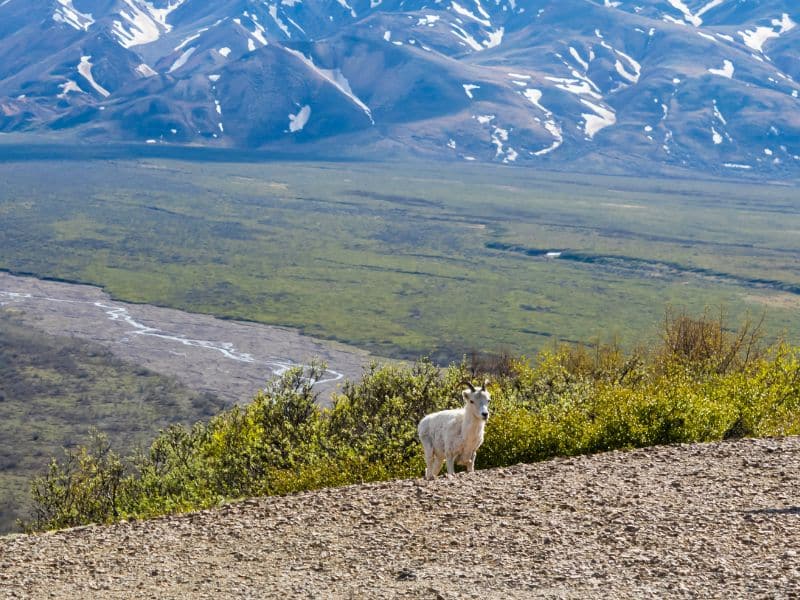
Their specially adapted hooves, with flexible pads that provide extra grip, aid them in navigating the precarious mountain terrains, making spots like the cliffs near Jade Lake prime viewing locations.
An intriguing aspect of Kobuk’s Dall’s Sheep is their social structure. Typically, the rams form bachelor groups, often engaging in head-butting contests to assert dominance, while ewes and lambs move in separate clusters.
The life of a Dall’s Sheep in Kobuk, marked by seasonal migrations to evade predators and seek new pastures, is a powerful testament to the Arctic’s cyclical rhythms.
Observers are often treated to a blend of drama, from fierce contests between rival rams to the tender moments between ewes and their lambs.
Encountering a Dall’s Sheep in Kobuk Valley, with its pristine coat standing out against the rugged backdrop, is a breathtaking spectacle.
Their innate elegance, combined with their survival acumen, mirrors the delicate balance of power and grace that defines the Arctic.
Mew Gull
Over the shimmering waters of Kobuk Valley, the Mew Gull, with its graceful wings and plaintive calls, fills the sky. This medium-sized gull, known for its adaptability, can be found across diverse habitats, from freshwater lakes to coastal shores.
Areas around the Hunt River and the estuaries near Kiana are frequented by Mew Gulls, especially during nesting times.
These birds are opportunistic feeders, diving into the waters to catch fish, picking off insects in flight, or even scavenging when the opportunity arises.
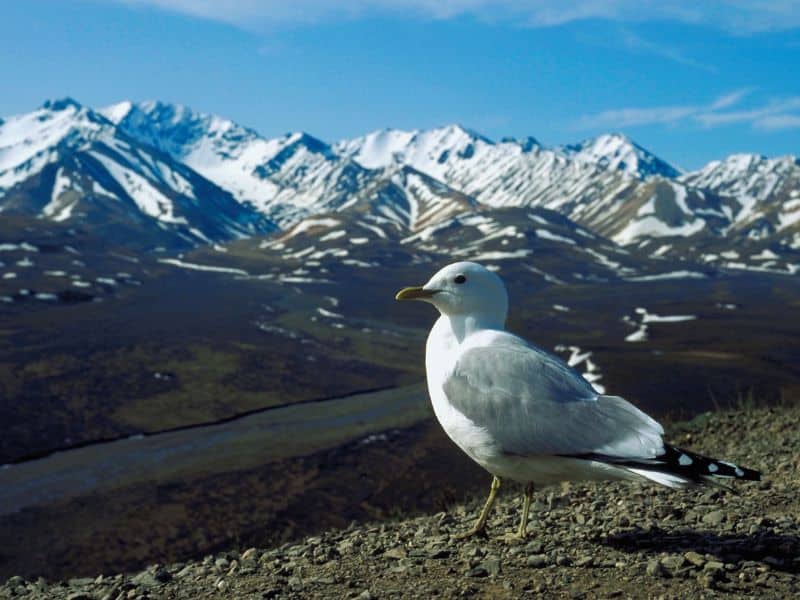
Kobuk’s Mew Gulls are known for their ground-nesting habits, often choosing concealed spots among tall grasses or shrubs to lay their eggs.
It’s not uncommon for travelers near Zane Hills to stumble upon their camouflaged nests, often guarded vigilantly by the parent birds.
A standout feature of these gulls in the park is their vocal nature. Their varied calls, ranging from high-pitched cries to softer mews, echo across the valley, adding layers to the park’s soundscape.
Observing a Mew Gull in Kobuk offers insights into the avian intricacies of the Arctic. Their survival tactics, combined with their omnipresent calls, reflect the nuances and rhythms of life in this vast wilderness.
Tundra Swan
The Tundra Swan, with its immaculate white plumage and regal bearing, graces the wetlands of Kobuk Valley like floating porcelain statues.
Their long necks and powerful wings highlight their evolutionary perfection, making them one of the most iconic birds of the Arctic.
The serene waters of the Kobuk River, particularly around its delta, and the tranquil shores of Walker Lake, often play host to these majestic birds.
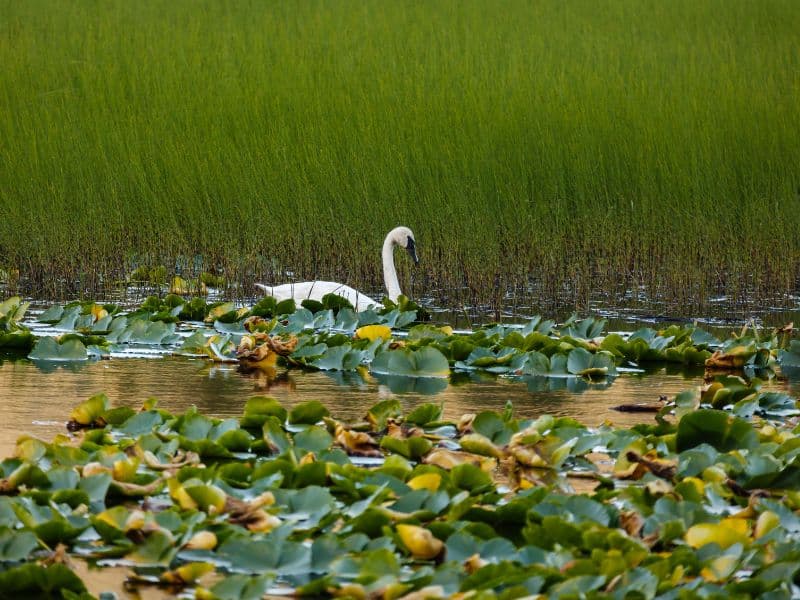
Their diets primarily consist of aquatic vegetation, but they’re also known to feed on small invertebrates.
Nesting along the quieter marshlands, especially near Onion Portage, Tundra Swans are known for their strong familial bonds.
The sight of cygnets learning to forage under the watchful eyes of their parents is a heartwarming spectacle common in the warmer months of Kobuk.
A hallmark of Kobuk’s Tundra Swans is their migration. Embarking on a thousand-mile journey, they connect the Arctic tundras to the temperate wetlands of the US, painting the skies with their elegant V-formations.
Witnessing a Tundra Swan in Kobuk Valley is an ethereal experience. The juxtaposition of their pristine elegance against the wild, untamed landscapes of the Arctic encapsulates nature’s profound contrasts.
Lesser Yellowlegs
With their signature long, yellow legs and agile forms, the Lesser Yellowlegs wade through Kobuk Valley’s wetlands, creating ripples both in water and among birdwatchers.
This slender shorebird, with its probing beak, is a symbol of the delicate biodiversity of the park’s marshy terrains.
The marshlands surrounding Nutuvukti Lake and the shallows of the Kobuk Delta are favorite spots for these birds. Their sharp bills probe the soft mud and shallow waters, hunting for insects, crustaceans, and small fish.
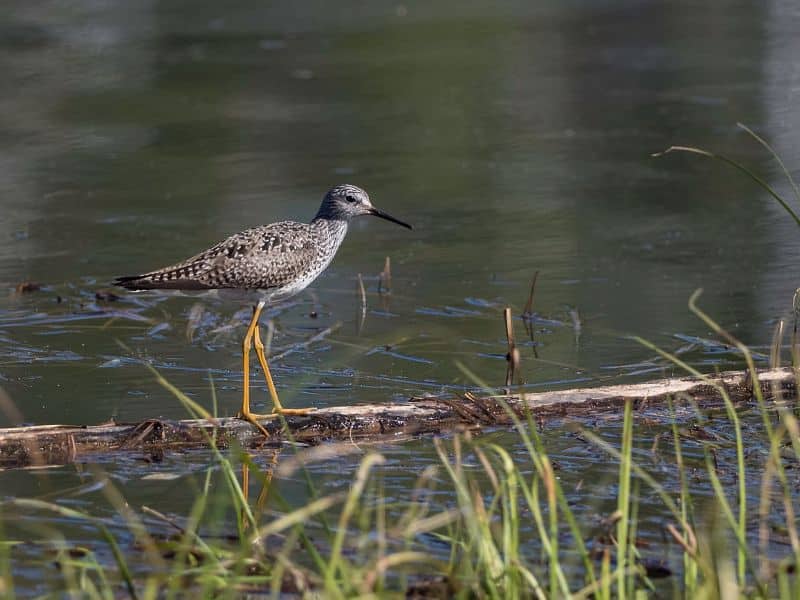
In Kobuk, the Lesser Yellowlegs exhibit fascinating breeding behaviors. Their nests, often a simple depression in the ground lined with vegetation, are usually concealed in tall grass or under shrubs.
The lively calls of the chicks, especially around the wet meadows of Selawik, add a melodious note to the valley’s soundscape.
A striking aspect of the park’s Lesser Yellowlegs is their migratory pattern. Covering vast distances, they showcase the avian spirit of endurance and adaptability, linking the Arctic wetlands to the tropical shores of South America.
Observing a Lesser Yellowlegs in Kobuk is a lesson in grace and diligence. Their meticulous foraging, set against the reflective waters of the wetlands, paints a picture of harmony and balance in nature’s grand tapestry.
15 Fascinating Facts About Kobuk Valley National Park
Kobuk Valley National Park, located in Alaska, is one of the least-visited and most unique national parks in the U.S. Here are 15 fascinating facts about this remarkable destination:
Sand Dunes in the Arctic: Despite being located above the Arctic Circle, Kobuk Valley boasts the Great Kobuk Sand Dunes, often referred to as the “Arctic Desert.”
These dunes cover 25 square miles and can rise as high as 100 feet.
Migration Path: Each year, about half a million caribou travel through Kobuk Valley during their migration, making it a significant location for observing this amazing natural phenomenon.
No Roads In: There are no roads leading into Kobuk Valley National Park. Visitors usually arrive by aircraft or by foot after a long journey.
Rich Archeological Site: The Onion Portage area is an important archaeological site. For thousands of years, indigenous people came to this spot to hunt caribou.
The tools and weapons found here have provided insights into 9,000 years of human history.
Above the Arctic Circle: About two-thirds of the park lies north of the Arctic Circle, giving it 30 days of continuous daylight in summer and 30 days of continuous darkness in winter.
Rare Park Visitation: Kobuk Valley is one of the least visited national parks in the U.S., with only a few thousand visitors each year.
This offers a truly remote and untouched wilderness experience.
Kobuk River: The park is named after the Kobuk River which flows for 61 miles through its boundaries.
This river is an essential travel route for both wildlife and the local indigenous people.
Ice Age Relics: The park’s ecosystems and features, such as the sand dunes, are largely a result of the last Ice Age. As the glaciers melted, they left behind a unique landscape.
Local Inhabitants: The Inupiaq Eskimos have lived in and around the Kobuk Valley region for thousands of years, relying on the resources the land offers for their subsistence way of life.
Variable Climate: Despite its Arctic location, the park experiences a wide range of temperatures, from a chilly -50°F in winter to a warm 100°F during some summer days.
Diverse Wildlife: Apart from the caribou, Kobuk Valley is home to a variety of wildlife, including black bears, grizzlies, wolves, foxes, moose, and more than 125 species of birds.
Lakes and Wetlands: The park houses the Kobuk River’s wetlands, providing a vital habitat for various bird species and other wildlife.
Mountain Ranges: The park is framed by the Baird and Waring mountain ranges, offering stunning vistas and topographies ranging from valleys to rugged peaks.
Cultural Heritage: The park works diligently to preserve the cultural heritage of the Inupiaq people.
Visitors can gain insights into the traditions, stories, and lifestyles of these indigenous Arctic inhabitants.
Limited Facilities: Due to its remote nature, Kobuk Valley National Park has limited facilities, making it a true wilderness experience.
Those who venture here should be prepared for a backcountry experience, bringing everything they need and adhering to a leave-no-trace principle.
This park is a hidden gem, providing an unparalleled combination of Arctic wonders, cultural heritage, and pristine wilderness.
Activities in Kobuk Valley National Park
Kobuk Valley National Park is a stunning mosaic of sand dunes, mountains, and wetlands.
This remote wilderness, untouched by roads, offers a truly unique Alaskan adventure for those intrepid enough to explore its vast expanse. Here’s a rundown of must-do activities:
Witness the Great Kobuk Sand Dunes
Amidst the icy terrains of the Arctic, the Kobuk Sand Dunes present a startling desert oasis.
Most expansive views can be found near the central section, especially around the Ahnewetut Creek.
Covering over 25 square miles with dunes rising up to 100 feet, they’re a spectacle best witnessed during late summer when temperatures average a mild 50°F (10°C).
Photographers will find the golden hour, just before sunset, to be especially enchanting, casting a radiant glow over this Arctic desert.
Watch the Caribou Migration
Join the ranks of the lucky few who’ve seen the majestic migration of half a million caribou.
These animals traverse the park twice a year, and the sight of their journey across the wild landscape is nothing short of awe-inspiring.
River Adventures
The Kobuk River, snaking through the park, offers a refreshing contrast to the sandy landscapes.
For the most pristine experience, launching from the Walker Lake area gives adventurers an unfiltered glimpse of the park’s watery arteries.
Navigate its meandering courses either by kayak or canoe. Summer months, particularly June, bring moderate river flow rates, making it suitable even for beginners.
But always remember: the Arctic waters can be unpredictable, so always prioritize safety.
Flightseeing Tours
Given the park’s remoteness, one of the best ways to witness its grandeur is from the air.
Flightseeing tours can be arranged from nearby communities, providing a bird’s-eye view of the park’s diverse landscapes.
Camping under the Midnight Sun
Within Kobuk Valley, the vast, open landscapes provide a canvas for the Arctic’s prolonged daylight.
Select a spot near the Salmon River for a serene camping backdrop. During the peak of summer, the sun barely dips below the horizon, bathing the park in a soft, persistent glow.
This phenomenon, lasting from late June to early July, provides campers ample opportunity to explore and savor the park’s nocturnal beauty.
Historical Insights
The ancient rhythms of life still echo in places like Onion Portage.
This archaeological site, situated on the northern banks of the Kobuk River, has witnessed human activity for over 12,000 years.
Visit during early September, when the region sees fewer rain showers, to walk amidst relics and tools left behind by indigenous inhabitants, offering a tactile connection to ages past.
Winter Activities
As snow blankets Kobuk Valley, the park transforms into an ethereal winter wonderland.
The areas near the Jade Mountains are particularly recommended for activities like snowmobiling and cross-country skiing.
December offers the thickest snow covers, and for those interested in dog sledding, local guides often provide immersive experiences, with the chance to steer your own team under the shimmering Northern Lights.
Conclusion
Kobuk Valley National Park is a unique ecosystem for wildlife encountering. With its boreal forests, tundra and sand dunes you can explore one of the most remote national parks in the United States.
From majestic grizzly bears to playful otters or more timid animals like foxes and hares, there are opportunities to observe some incredible creatures along your journey!
With careful planning, patience and an open mind this amazing place will reveal its secrets to intrepid travelers who seek a once-in-a-lifetime experience!

